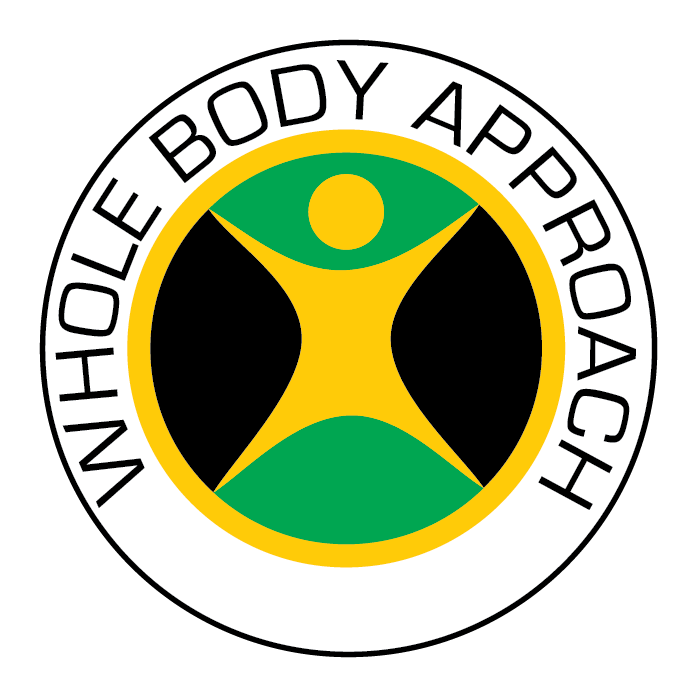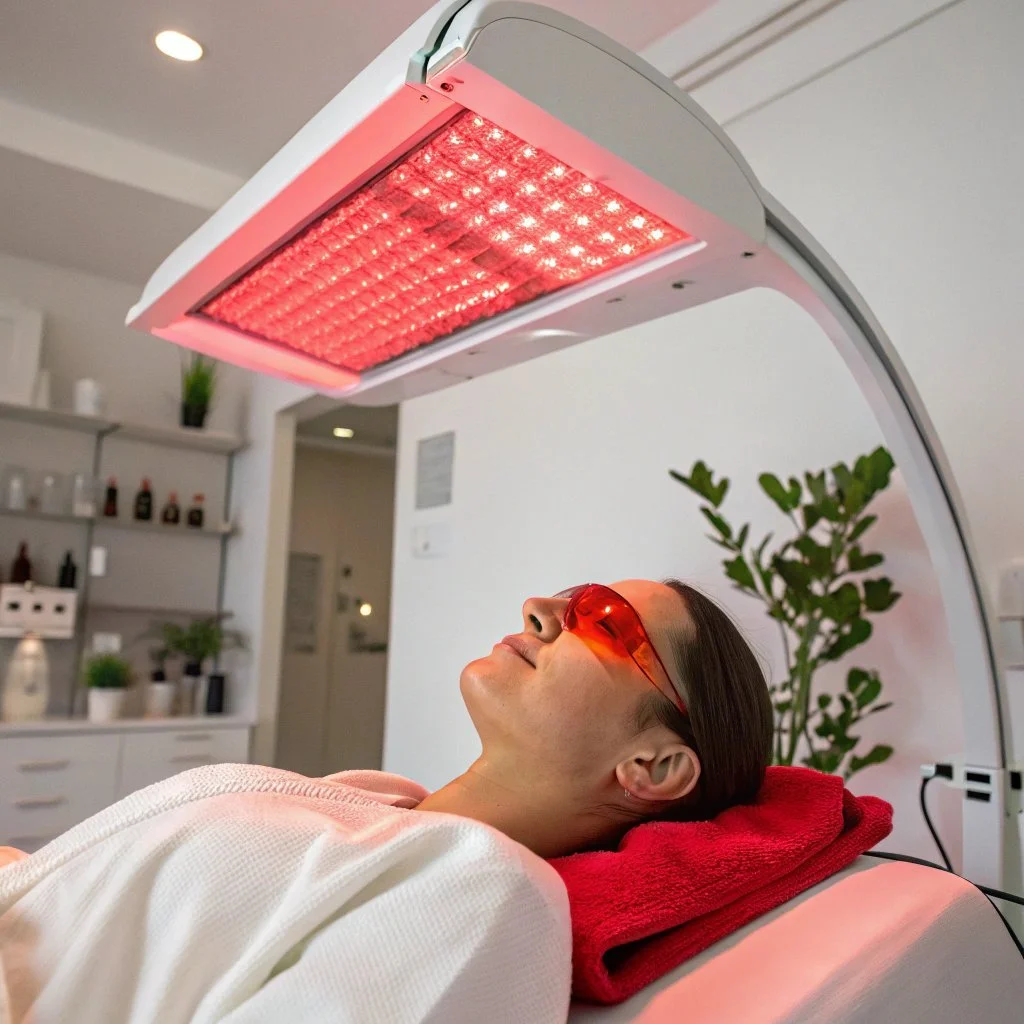Understanding Red Light Therapy: Benefits, LED Light Uses & Risks
As a personal trainer helping active adults and busy parents optimise their health and fitness, I always explore effective recovery tools. One treatment that's gained significant attention is red light therapy (RLT). This non-invasive approach uses specific wavelengths of light to potentially improve skin health, reduce inflammation, and support recovery after workouts. But what exactly is it, and could it benefit your wellness routine?
The Science Behind Red Light Therapy
Red light therapy (photobiomodulation or low-level light therapy (LLLT)) uses low-wavelength red light to penetrate the skin and potentially stimulate cellular processes. Unlike ultraviolet light, red light doesn't burn or damage skin tissue, making it generally safe for regular use19.
The science is fascinating. Mitochondria, the powerhouses of our cells, absorb red light wavelengths (typically 630-700 nm). This absorption may help cells produce more adenosine triphosphate (ATP), providing more energy for cellular function and rejuvenation6.
How Does It Work? When red light reaches your skin cells, it:
Floods cells with ATP energy, potentially leading to better cell proliferation and tissue repair7
Helps improve blood flow to treated areas by releasing nitric oxide from mitochondria7
Reduces inflammation in applied areas, which can inhibit healthy repair processes7
Improves surface tension in cells, helping protect energy metabolism7
The history of red light therapy dates back to 1903 when Danish physician Niels Ryberg Finsen won the Nobel Prize for discovering that concentrated red light could accelerate the healing of sores3.
Benefits of Red Light Therapy
Anti-ageing and Skin Health Benefits
Red light therapy may improve skin appearance by:
Increasing collagen production, giving skin more elasticity6
Boosting fibroblast production, which helps create collagen and tissue fibers6
Enhancing circulation between blood and tissue cells6
Reducing fine lines and wrinkle severity6
Research suggests regular treatments can lead to noticeable improvements in skin texture, tone, and overall appearance3.
Anti-Inflammatory Benefits
Inflammation is at the root of many health issues, from sore muscles to chronic conditions. Red light therapy has shown promising anti-inflammatory effects that may:
Help calm inflamed tissues throughout the body6
Reduce redness and irritation in skin conditions5
Support recovery after intense workouts10
This anti-inflammatory effect could be particularly valuable for active adults and busy parents constantly pushing their bodies.
Using Red Light Therapy for Specific Conditions
Acne Treatment with Blue and Red Light
For those struggling with acne, combining red and blue LED light therapy may be particularly effective:
Blue light targets oil glands and kills acne-causing bacteria beneath the skin4
Red light reduces inflammation and promotes the healing of existing blemishes2
Together, they can decrease scarring and provide anti-inflammatory effects4
This combination approach has made LED light therapy a popular treatment option for acne without the harshness of some topical medications2.
Wound Healing and Recovery
The regenerative potential of red light therapy makes it interesting for wound healing:
Red light may stimulate healing processes by increasing circulation and energy production in cells6
Near-infrared light (a slightly longer wavelength) can penetrate deeper tissues to promote healing5
The therapy may help decrease recovery time for injuries and workout-related muscle damage10
NASA has even studied red LED light for its ability to accelerate the healing of oxygen-deprived wounds and promote the growth of skin, bone, and muscle cell cultures3.
Collagen Production and Skin Elasticity
Collagen production naturally decreases as we age, leading to sagging skin and wrinkles. Red light therapy may help:
Stimulate collagen production in deeper skin layers5
Improve skin elasticity and firmness over time10
Reduce the appearance of scars and stretch marks by promoting healthy tissue regeneration2
This collagen-boosting effect could particularly appeal to parents concerned about post-pregnancy skin changes or active adults noticing the first signs of ageing.
Red Light Therapy at Home vs. Professional Treatments
At-Home Device Options
The market now offers numerous at-home red light therapy devices:
LED masks that cover the entire face
Handheld wands for targeted treatment
Panel systems for treating larger body areas
Combination devices that offer multiple light wavelengths
For safety reasons10, at-home devices typically use lower energy levels than professional equipment. While this means they may require more frequent use to achieve results, they offer convenience and cost savings over time.
Choosing an At-Home Device: When shopping for a red light therapy device, consider the following:
Wavelength (ideally between 600-900 nanometers)10
Power density (20-200 mW/cm² for skin issues)10
Device type that fits your lifestyle (mask, panel, handheld)10
FDA clearance for safety9
Professional vs. At-Home Treatment
Professional treatments usually deliver:
Stronger light intensity
More consistent results
Expert guidance
At-home options provide:
Convenience
Lower long-term cost
Ability to use more frequently
"At-home red and blue light LED masks use much lower energy levels than what you would expect in an in-office treatment," so you likely need to use them daily to see results12. Most experts recommend using at-home devices 3-5 times weekly for optimal benefits10.
Potential Risks of Red Light Therapy
Red light therapy is generally safe with minimal side effects when used correctly. However, like any treatment, there are considerations:
People taking medications that increase skin sensitivity should consult a doctor first1
Those with a history of skin cancer or eye disease should seek medical advice before starting1
Very high light intensities could potentially cause skin redness or blistering1
Eye protection is recommended during treatment to prevent potential damage1
It's important to note that despite some marketing claims, red light therapy doesn't cause weight loss1. It may temporarily change body shape through inflammation reduction but is not a weight loss solution.
The Effects of Red Light Therapy: What Science Says
Research on red light therapy continues to evolve. Current evidence suggests:
Multiple studies indicate benefits for skin appearance and healing36
Positive effects on pain reduction, particularly for inflammatory conditions1
Potential improvements for temporomandibular dysfunction (TMD) and some forms of arthritis1
Promising results for hair growth in certain types of hair loss6
However, many studies have been small or limited in scope. While results are encouraging, larger controlled trials are still needed to fully understand the extent of benefits1.
Using Red Light Therapy at Home Safely
If you're considering adding red light therapy to your wellness routine, follow these guidelines:
Start with shorter sessions (5-10 minutes) and gradually increase as tolerated
Use 2-3 times weekly for general maintenance10
Keep sessions under 20 minutes to avoid potential cell damage10
Cleanse skin before treatment and sanitise devices regularly to prevent contamination10
Be consistent—results typically require ongoing treatment over several months10
For best results, the device should be touching or nearly touching your skin to ensure energy absorption12.
Conclusion: Is Red Light Therapy Right for You?
Red light therapy presents an intriguing, non-invasive treatment option for various skin and health conditions. It could be a valuable addition to your wellness toolkit with potential benefits ranging from improved skin appearance and reduced inflammation to enhanced recovery.
As a personal trainer, I appreciate that red light therapy is generally safe, doesn't require downtime, and can complement other healthy habits. However, results vary by individual, and consistency is key. If you're considering red light therapy, start with realistic expectations and give it time to work.
Whether you choose professional treatments or an at-home device, red light therapy might just be the boost your recovery routine needs—particularly if you're balancing an active lifestyle with parenting responsibilities or other demands.
FAQ About Red Light Therapy
How long does it take to see results from red light therapy?
Results vary depending on your specific concerns and treatment consistency. Some people notice improved skin tone and reduced inflammation within a few weeks, while anti-ageing benefits typically require 2-3 months of regular use10.
How often should I use red light therapy?
For at-home devices, 3-5 sessions per week is typical. Each session lasts 5-20 minutes, depending on the device and treatment area10.
Is red light therapy safe for all skin types?
Red light therapy is generally considered safe for all skin types. However, those with darker skin tones should be cautious with blue light, as it might increase the risk of hyperpigmentation. Pure red light is typically recommended for skin of color1012.
Can I combine red light therapy with other treatments?
Red light therapy often complements other skin treatments and fitness recovery methods. It may enhance the effects of your skincare products and support muscle recovery alongside other approaches12.
Does red light therapy treat pain?
Research suggests red light therapy may help relieve some pain, particularly inflammation-related. It has shown promising results for conditions like arthritis and muscle soreness16.
Will red light therapy cause cancer?
No. Unlike ultraviolet (UV) light, red light therapy doesn't cause skin cancer. It doesn't contain cancer-causing UV rays9.
Can I overdo red light therapy?
While generally safe, overuse could potentially cause skin irritation. It is recommended that users follow device guidelines and keep sessions to a maximum of 20 minutes10.
Citations:
https://www.webmd.com/skin-problems-and-treatments/red-light-therapy
https://activecarechiro.co.uk/2023/10/red-light-therapy-for-acne/
https://www.foreo.com/mysa/the-science-behind-red-led-light-therapy-and-its-benefits
https://www.healthline.com/health/beauty-skin-care/led-light-therapy
https://www.skininnovation.co.uk/laser-treatments/dermalux-led-skin-treatment/
https://www.womenshealthmag.com/beauty/g42005167/best-red-light-therapy-tools/
https://www.aad.org/public/cosmetic/safety/red-light-therapy
https://www.goodhousekeeping.com/beauty-products/g41213734/red-light-therapy-at-home-devices-tools/
https://my.clevelandclinic.org/health/articles/22114-red-light-therapy
https://time.com/7071807/do-at-home-red-light-masks-really-work/
https://www.health.harvard.edu/diseases-and-conditions/led-lights-are-they-a-cure-for-your-skin-woes
https://my.clevelandclinic.org/health/treatments/22146-led-light-therapy
https://www.news-medical.net/health/Light-Therapy-Safety-and-Side-Effects.aspx
https://www.today.com/health/skin-beauty/red-light-therapy-rcna142437
https://www.laserclinics.co.uk/blogs/what-you-need-to-know-about-led-light-therapy/
https://www.consol.eu/articles/let-s-talk-about-the-benefits-of-red-light-therapy/
https://ledtechnologies.com/blog/the-science-behind-led-light-therapy-skin-rejuvenation/
https://www.glamour.com/gallery/best-red-light-therapy-devices
https://www.forbes.com/sites/forbes-personal-shopper/article/best-led-face-mask/
https://www.nytimes.com/wirecutter/reviews/red-light-therapy-devices/
https://neoelegance.co.uk/blogs/skin-science/how-does-red-light-therapy-work
https://www.facialperfection.co.uk/how-can-led-light-therapy-combat-acne-and-inflammation
https://www.projectebeauty.uk/blogs/news/the-dangers-of-led-face-masks-you-should-know-about
https://www.webmd.com/beauty/what-is-led-light-therapy-for-skin
https://www.blockbluelight.co.uk/collections/red-light-therapy-panels

